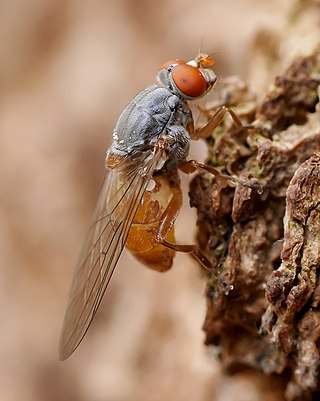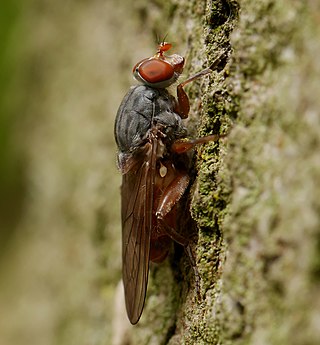The Middle Elbe Biosphere Reserve is a Biosphere Reserve in the German Federal state Saxony-Anhalt.

Eristalinae are one of the four subfamilies of the fly family Syrphidae, or hoverflies. A well-known species included in this subfamily is the dronefly, Eristalis tenax.

Brachyopa is a Holarctic genus of hoverflies whose grey and brown colouration is unusual for this family and these flies can easily be overlooked amongst members of other fly families. The larvae can be found under the bark of dead branches and trees in decaying sap.

The Brachyopini is a tribe of hoverflies. Unlike many members of this family these flies are generally darker and less colourful though some genera contain species with an attractive metallic lustre e.g. Chrysogaster. Some like Brachyopa are associated with sap runs where their larvae feed on decaying sap. Others are found in boggy areas where their often semiaquatic larvae feed on decaying organic matter.

Brachyopa insensilis is a Palearctic species of hoverflies.

Brachyopa scutellaris is a European species of hoverfly.

Brachyopa bicolor (Fallén, 1817) is an uncommon species of syrphid fly. It has been observed in Central Europe from Germany to Greece. Hoverflies get their names from the ability to remain nearly motionless while in flight. The adults are also known as flower flies for they are commonly found around and on flowers, from which they get both energy-giving nectar and protein-rich pollen. Larvae for this genus are of the rat-tailed type. B.bicolor larvae have been described from sap runs in Aesculus, Fagus and Quercus.
Hammerschmidtia ferruginea , the Aspen hover fly, is a rare, species of syrphid fly. It has been observed in Canada, Alaska and the northern United States. Hoverflies get their names from the ability to remain nearly motionless while in flight. The adults are also known as flower flies for they are commonly found around and on flowers, from which they get both energy-giving nectar and protein-rich pollen. Larvae for this genus are of the rat-tailed type. Hammerschmidtia ferruginea larvae have been described by Rotheray.
Brachyopa atlantea is a European species of hoverflies.
Brachyopa grunewaldensis is a European species of hoverflies.
Brachyopa bimaculosa is a European species of hoverflies.
Brachyopa maculipennis is a European species of hoverfly.
Brachyopa paradoxa is an Asian species of hoverfly.
Brachyopa stackelbergi is an Asian species of hoverfly.
Brachyopa tabarkensis is a European species of hoverflies.
Brachyopa tristis is an African species of hoverfly.
Brachyopa cruriscutum is an Asian species of hoverfly.
Brachyopa exigua is an Asian species of hoverfly.
Brachyopa minima is a European species of hoverfly.
Brachyopa vernalis is a species of hoverfly.




